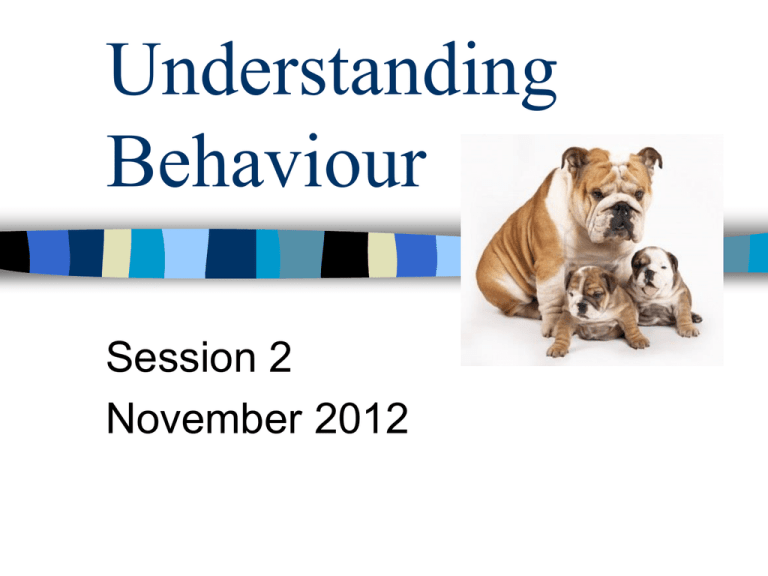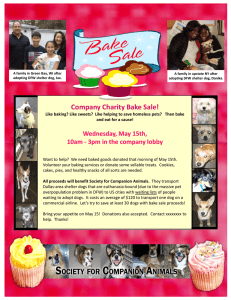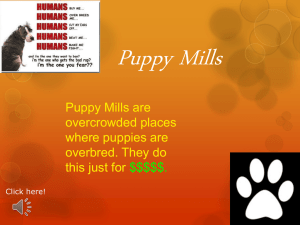
Understanding
Behaviour
Session 2
November 2012
Looking at where the dog has come from, the
developmental and behavioural changes that occur
from birth (and prior to it), through puberty and into
adulthood and how dogs communicate between
themselves and to us.
Domestication & Evolution
Prior to domestication we must think and look
at evolution.
Evolution is a gradual change, through a
process of natural selection to allow animals
to become better suited to their environment
and promote both survival and reproduction.
Animals (including humans are evolving all
the time)
Example:
Evolution of The Dog
Creodonts (100-50mya)
Miacis (54-38 mya)
Hesperocyon (38-26)
Cyodicitis (19 mya)
Tomarctus (12 mya)
Canidae (2 mya)
Evolution of
The Dog
Taxonomy
“The classification of
organisms in an ordered
system that indicates
natural relationships.”
http://www.thefreedictionary.com/taxonomy
Kingdom:Animalia
Phylum:Chordata
Class:Mammalia
Order:Carnivora
Family:Canidae
Genus:Canis
Species:C.lupus
Subspecies: C.lupus
familiaris
Added 1993
Kingdom:Animalia
Kingdom:Animalia Kingdom:Animalia
Phylum:Chordata
Phylum:Chordata Phylum:Chordata
Class:Mammalia
Class:Mammalia
Class:Mammalia
Order:Carnivora
Order:Carnivora
Order:Carnivora
Family:Canidae
Family:Canidae
Family:Canidae
Genus:Canis
Genus:Canis
Genus:Vulpes
Species:C.lupus
Species:C.aureus
Species:vulpes
Subspecies: C.lupus
familiaris
(golden jackal)
(red fox)
Domestication
Domestication= “the process of
enfolding a species into human society
and taking responsibility for it’s
husbandry and control over it’s
breeding” (J.Clutton-Brock)
Domestication of Dog
Theory one:
Domestication of the Dog
Theory 2:
Key points to remember…when using
canine ancestry to understand dog behaviour
Once were solitary, more recently social
Hunters, but also scavengers
Adapted (to feel non-threatened by humans)
Weaker/less effective predators most
likely self-domesticated through natural
selection
Domestication started over 10 thousand
years ago.
Domestic Evolution of the Early
Dog how the breed groups developed
Guarding = working dogs
Food Source
people started keeping stock
herding =pastoral
(humans got sense!)
companion= toy + utility
Hunting
human hunting methods developed
treking
retrieving
chasing+capturing
hounds
gundogs
hounds+ terriers
How did the breeds develop?
Through breeding like with like both due to region and traits.
N. American
Eskimo
Chinese
Prehistoric
Indian
Chow Dingo
Borzoi
Toy
Spaniels
Pekin Bulldogs Pug
European
Pharoh
Greyhound Mastiff Shepherd Spitz
Saluki
Afghan
Newfie
St. Ber
Gt. Dane
Deerhound
Blood
hound
Terriers
Gundogs Maltese
Spaniels
Selective
Breeding
(changing and developing breeds-selecting traits)
Puppies…
At birth the brain is not fully developed
Neurons are in place, but neurons have
not become connected.
Involuntary nervous functions are
developed e.g those responsible for
breathing and heart rate, but voluntary
neural connections are yet to be made
Neural connections are
made though the chemicals; neurotransmitters.
Connections are made as a result of the
experiences of the puppy, allowing for
associations
As individual puppy’s experience different
things, puppies develop their own ‘wiring’.
In training…
In training we aim to link (associate) a
stimulus (cue) to a response
(behaviour) in the dogs mind so that it
occurs in an almost involuntary nature.
This requires repetition and
reinforcement to strengthen the
association.
Affects on neural ‘wiring’ and
consequently behaviour before
birth
Diet of dam
Health of dam
Puppy inter-uterine position
Puppy’s birth number
Puppies…
Are altrecial at birth
Initial stimuli to respond to is warmth
and possibly pheromones from the
mammary glands
Ability to find the teat and mother’s
warmth is known as ‘biotonus’
(meaning vitality)
Warmth triggers the action of moving along to
find teat; an instinctive behaviour performed
to anything of the same stimulus.
Suckling is also instinctive, and puppies are
perfectly physically adapted to do this.
As development continues respond to
auditory stimuli and then visual (5 weeks)
Learning by association occurring at this early
stage (pheromone
nipple)
(nipple=food)
The bitch…
Performing instinctive behaviours
Licking
Cleaning pups
Responding to puppy calls (although
responds better if can see them also)
Sleep…
Newborn puppies sleep up to 90% of the
time. Functions of sleep include:
Growth time
Utilisation of energy for growth
Latent Learning (memory consolidation)
Feeding Development
Thought to be born with chemical
receptors developed to detect milk
No early recognition or interest in meat
until 3 weeks
Start to ‘dabble’ in food.
At 5 weeks eat ‘solid’ food.
Early Competitiveness over
Resources
Stronger puppies will compete for the
fuller teats and will push weaker
puppies off teats when theirs dries up.
This ability to ‘win’ may have an effect
on ‘personality’ development.
Puppy Senses Development
Vision
Puppy born blind, but eyes start to open at 1016 days old
At approximately 4 weeks starts to follow
moving objects
Five week old recognises mother by sight
At six weeks demonstrates avoidance
behaviour to apparently negative visual
stimuli
Vision fully developed at 4 months (vision maturation,
due to nerve cell growth and neural pathway development)
Puppy Senses
Development
Hearing
Ear canals open around 2 weeks and puppy
starts to react to sounds
Puppies will not have an inherent understanding
of noise, it must be learnt (e.g mother’s
growl)
Fully hearing is developed by 5 weeks
(although can depend on breed and individual
differences).
Lapping
Regurgitated food is often the
transition between liquid and
solids
It is thought that the licking of
he mothers face may be the
precursor for lapping
Behaviours not occur by all
pups and dams (reducing
due to domestication).
Lapping
Factors that encourage lapping:
Diminished Milk supply
Reduced need for maternal contact
Hunger
Desire / motivation to achieve ‘reward’
of ‘new’ food
Behaviour of the Dam
Maternal Behaviour:
Unsure as to whether mothering skills are
learnt or inherited
Isolates for birth
Fixed action pattern of behavioural responses
Can be protective of puppies
Bitches can also kill unwell puppies (apparent
to bitch as don’t behave ‘normally’)-natural
selection)
Licks puppies for elimination behaviour
Bringing puppies back to the nest
Behaviour of the Sire
Paternal Behaviour
In domestic dogs the
sire has no role in the
puppies development
In the wild they can act
as educators from
seven weeks
Juvenile Behaviour
Play
Most mammals play
…but most mammals only do this when
young.
Through Domestication Dogs have
remained “neotenous”.
We encourage them to
remain juvenile.
Theories as to why dogs play
Helps with development of bone and muscle
Teaches useful communication skills
Teaches hunting skills (although not required
in domestication)
Teaches co-operation between group
members
Teaches about surrounding environment
Allows for trial and error learning
Puppy enjoys doing it!…functional behaviour.
Play as Practise
Courtship (stand reflex, mounting and
thrusting)
Communicationvisual and chemical.
Physical Thresholds-tactile (soft bite)
Affects of hormones
Prenatal exposure to male and female
hormones will have influenced brain
development to promote typical male
behaviours and typical female
behaviours.
Affects of hormones
The next surge of hormones occurs at
puberty.
Time of puberty varies depending on
breed
Puberty is defined as “time of sexual
maturity” (maturation)
Affects of Puberty- Male
(General)
Increased hair growth
Scent marking
More prepared to protect territory (items of
value)
Roaming
Increased arousal (more excitable)
Re-chewing
More vocal
Disobedient to previously taught cues
More aloof/independent/curious
Affect of Puberty- Females
(General)
Signs of oestrous
More protective
More sensitive
Interest in males (flirty)
Scent marking
Re-chewing
More vocal
Disobedient to previously taught cues
More affectionate
Maturation
Sexual (leg cocking and
first seasons)-6 to 9 months
Physical (still occurs in neutered dogs…although can be
slower)-18-24 months
Males grow taller, chest drops and expands, mane may develop
around neck and shoulders (sexual dimorphism). Female, after
first season: vulva enlarges, increases body mass and teats will
increase in size.
Psychological hard to quantify, often dependant on
experience and possibly breed also.
Socialisation and the
dog as a social being
Between 3-twelve or thirteen weeks the
puppy is said to be in a ‘critical period’.
During the time the puppy must be socialised
with people and dogs so that s/he knows how
to behave with them.
Effects of improper
socialisation includes:
nervousness or over excitable.
(both over arousal)
Inter Specie sociability
Dogs are social animals
But through domestication have
adapted to be sociable with other
beings
Communication between
species is different but some
elements are the same
(e.g affection and companionship)
The Dog as a Predator
Often after maturation, behaviours described as
things such as “increased prey drive” may occur.
This is often the demonstration of breed specific traits
(from nature and potentially nurture)
Although the dog has the physical, physiological,
behavioural and social adaptations to be a successful
predator few domestic dogs perform the repertoire of
behaviours that are ‘hunting’
‘Prey drive’ can be linked to
“aggressive” behaviour in
dogs.
Pack Theory
A group of dogs is called
a ‘pack’
Wild dogs establish packs and
relationships within them through
complicated rituals
Packs of pet dogs may also establish
relationships based upon ‘personalities’
(level of confidence), the motivation for
specific resources and affected by their
communication skills
Dogs more often ‘in charge’ are regularly
described to be ‘dominant’, and those
that are not ‘submissive’
Dominance is inter-changeable and codominance can exist
Pack Theory-hierarchy
The dog pack is often described to have a hierarchy
Establishing the relationship between two new dogs can
happen quickly, but usually a lengther process when the
introdction of a new dog into the home.
There are various forms of hierarchy with different groups
Linear A
B
C
D
Triangular
A
Square A
B
B
C
C
D
IMPORTANT NOTE: Hierarchies do not exist
across species. Animals that are ‘gregarious’ often
co-exist, and animals that are ‘social’ may except
others of a different specie into their group, but the
same relationships do not exist between them, and
they do not communicate in the same way.
Being “the pack leader”
Some so called ‘trainers’ will speak of the necessity
for owners to be pack leaders.
In order to do this they advocate ‘mimicking’
supposedly natural dog communication
Being “the pack leader”
As we are not dogs, most likely dogs do not
understand this communication from other, and the
methods used to achieve this communication goal is
very unethical and teaches very little other than the
dog to be frightened (rather than submissive) to
humans.
Dogs have evolved and adapted to be a welcomed
member of a ‘family’, we are not existing as part of
the dog’s pack.
“Dominant Dogs”
If dogs start to establish behaviours that can
appear to ‘dominant’ it is most likely a
combination of that dog’s personality and a
lack of training and consistency from the
owner.
If we are inconsistent dogs get confused,
confusion leads to frustration and frustration
sometimes aggression.
Inter and Intraspecie
Communication
Communication
Communication occurs upon production of a
signal by one animal that is recognised and
alters the behaviour of the receiver of the signal
Communication can be:
Visual
Auditory
Chemical
Tactile
Through Energy??
Visual Communication
This is communication we can see i.e body language
In science we aim to be objective in the description of animal
communication
We often start with a base line visual communication, often
referred to as ‘normal’, or otherwise “the animal not
responding to any novel stimulus in the environment”
Positive stimulus
Positive arousal
normal
Negative Stimulus
Negative arousal
From there we extend to see the animal perform visual
communication which occurs as a response to positive or
negative stimulus (arousal).
Visual Communication
Positive Arousal = Distance Decreasing Signals= Affiliative Behaviour
Negative Arousal=Distance Increasing Signals= Agnostic Behaviour
Both occur on a scale
Parts of the Dog to Observe in
Intra or Inter Specie
Communication
General “Normal” Visual
Communication
Breed
dependant
Familiar/Obvious “Positive
Arousal” Visual
Communication
Positive Arousal
•Demonstrate arousal with sensory responses
•Switch off other sensory inputs
•Over exaggerate clear positive body signals
Familiar/Obvious“Negative
Arousal” Visual
Communication
Negative Arousal
Two types:
Flight based
•Make themselves smaller
•Withdraw/Submit (show they have no defences)
•May change to fight based if pushed
“Negative Arousal” Visual
Communication
Negative Arousal
Two types:
Fight based
•Make themselves look bigger (sometimes lower)
•Show defences
•Prepared to protect/defend (resource related)
More subtle signals of positive
arousal (Distance decreasing
signals)- dogs
•Play Bow
•Easy Wagging tail
•Flicking Tongue
•Submissive Grin
•Rollover/tap out
•Submissive Licking
•Relaxed/Soft Eye
More subtle signals of negative
arousal (anxious stress)- dogs (flight)
•·Yawning
•·Teeth Chattering
•Pacing
•Sweaty Paws
•Slow/Little
movement
•Lip Licking
•Whale eye
•Not eating
•Urination
•Ears pinned back
•Freezes
•Excessive Salivation
•Tucked/Low tail
•Stiff Posture
•Stretching
•Trembling
•Muscle Ridges
•Urogential Checking
•Shallow/Fast respiratory
Rate
Signals not occur in a vacuum,
must be taken in context
More subtle signals of negative
arousal- dogs (fight)- distance
increasing
•Marking territory
•Hard Eyes
•Tooth Displays
•Ears Alert/Forward
•Tense Body
•Heightened Posture/Position
•Lowering Head and neck
•Excessive barks
•Piloerection
•Tail High and Fast/Flagging
Sometimes dogs show communication referred to as
‘appeasing’ signals. This typically means they have experienced
a stressor (negative arousal) and are trying to calm
themselves/the situation.
•Look Aways
•Paw Raises
•Sniffing
•Sneezing
•Scratching
•Blinking
•Shaking Off
Auditory Communication
Bark- an alert, most likely
an adapted behaviour.
Easily socially learnt
Howl- attention seeking
behaviour as both
positive and negative
arousal
Whine- stress signal
Growl- warning signal
Chemical Communication
Release of Pheromone
Release from pads, anal
glands and face
Chemicals remain
longer than visual
signals often given
at the same time.
Tactile Communication
Seen mostly as:
Play
Affection or
Aggression
Behaviours of
the elderly dog
Behavioural changes will occur in the
older dog due to:
Illness and Disease (causing pain and
discomfort)
Hormone Production (and lack of)
Altered Sensory Perceptions
Inability to communicate effectively
Behaviours of the elderly dog
In the older dog:
Reflexes are slower
Memory loss occur (meaning rehearsal
of trained cues is required regularly)
Can get confused and act senile
Transmission of neurological messaging
slows from 200 mph to 50mph
Conclusion…
Understanding the development of the dog and
its associated behaviours is important.
We have huge responsibilities as a dog owner,
in initial and continual socialisation and
training, and as a
potential dog trainer
to know how
behaviour and
training can be
effected by
developmental stage.







